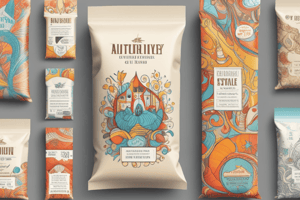Podcast
Questions and Answers
What is a key physical property that packaging materials must possess?
What is a key physical property that packaging materials must possess?
- The material must be transparent to allow visibility of the product.
- The packaging should be eco-friendly and biodegradable.
- The packaging must enhance the taste of the product.
- The surface must enable clear labeling. (correct)
Which chemical property is essential for packaging materials?
Which chemical property is essential for packaging materials?
- The closure must be able to absorb release agents.
- The container should not react with the product. (correct)
- The product must dissolve in the packaging material.
- The packaging must contain additives to enhance stability.
What biological property should packaging materials demonstrate?
What biological property should packaging materials demonstrate?
- The packaging must facilitate the growth of beneficial bacteria.
- Packaging should be made from only natural materials.
- Materials must support microbial growth for stability.
- The container must withstand insect attack. (correct)
What criteria should be included when selecting the packaging material?
What criteria should be included when selecting the packaging material?
Which factor is important regarding the physical and chemical characteristics of the product?
Which factor is important regarding the physical and chemical characteristics of the product?
Flashcards
Packaging Material Properties
Packaging Material Properties
Packaging materials must be impervious to contaminants, withstand heat (sterilization), enable labeling, suitable size, light-protective if needed, and not absorb product substances.
Chemical Compatibility
Chemical Compatibility
Containers and closures mustn't react with each other or the product; the product shouldn't react with the container or closure, nor extract or yield substances to or from the container.
Biological Stability of Packaging
Biological Stability of Packaging
Packaging needs to withstand insects, resist mold growth, and minimize damage to cellulosic materials through methods like impregnation.
Selection Criteria for Packaging
Selection Criteria for Packaging
Signup and view all the flashcards
Product Considerations for Packaging
Product Considerations for Packaging
Signup and view all the flashcards
Study Notes
Packaging Materials
- Packaging materials should be impervious to contaminants (solids, liquids, gases, vapors, microorganisms).
- Packaging must withstand heat for sterilization processes.
- Packaging surfaces should allow for clear labeling (especially with plastics).
- Materials must be light-resistant (ultraviolet absorbent) if needed.
- Materials must not absorb substances from the product itself.
- Materials must not release substances into the product.
- Packaging and closures should not react with each other or the product. This is especially true for combinations of dissimilar materials.
Chemical Properties
- The container and closure should not react with each other or with the product—even in combination.
- Products should not extract substances from the container/closure (e.g. bactericides from injection solution to rubber).
- Containers/closures should not release substances into the product (e.g. alkalis from glass, plasticizers from plastics).
Biological Properties
- Packaging materials should resist insect attack if necessary.
- Packaging should not support mold growth.
- Prevention of mold growth can be done using impregnation techniques.
Selection Criteria for Packaging
- Market research, distribution systems, production capabilities, and regulatory considerations should be surveyed before package selection.
- Packaging should consider the product's properties, route of administration, target patient demographics (infants, children, adults, etc.), and legal requirements.
Studying That Suits You
Use AI to generate personalized quizzes and flashcards to suit your learning preferences.




